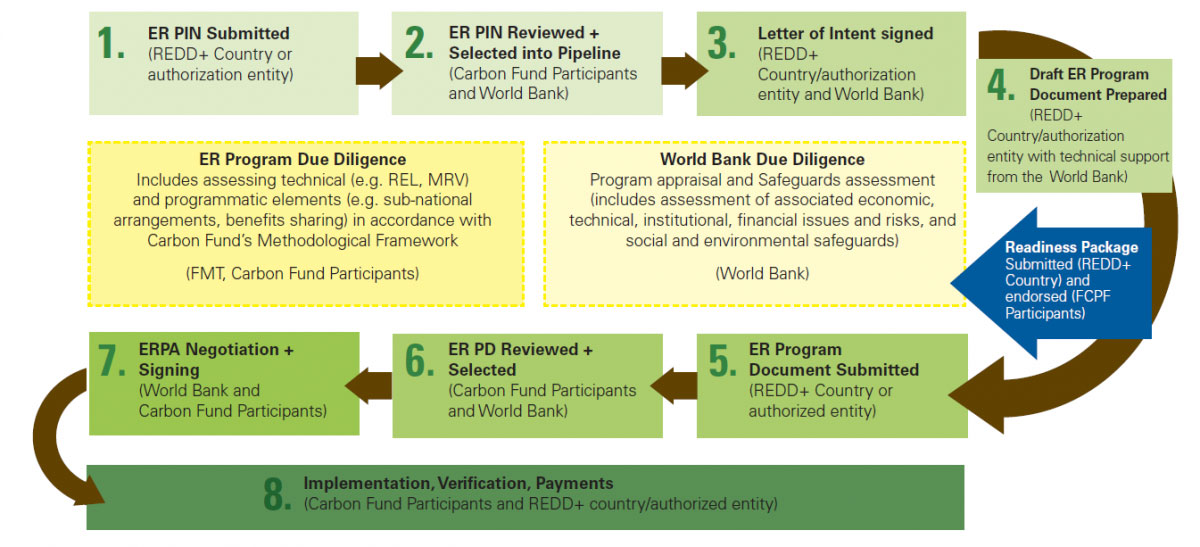UPDATE: The Carbon Fund has provisionally approved the first two REDD+ programs in DRC and Costa Rica. See comments below for further details.
Next week in Paris, the Carbon Fund will decide whether to approve its first two results-based payment programs for conserving tropical forests. After eight years writing a charter, negotiating a rulebook, and vetting proposals, it’s long past time to finally do so. Saying yes to Costa Rica and the Democratic Republic of Congo (DRC)—the two countries that have submitted emission-reduction program proposals—would not only be a boon to those two countries, but it would also send a welcome signal of encouragement to other countries waiting in the wings. Further delaying acceptance could see energy around climate and forest finance drift away to other initiatives.
The Carbon Fund of the Forest Carbon Partnership Facility is an 11-donor, $750 million fund for conserving tropical forests, housed at the World Bank. Unique among multilateral funds, the Carbon Fund is entirely results-based, that is, it pays participating forest countries for each ton of emissions from deforestation they avoid. The Carbon Fund was set up to be both a conduit for public donations and a bridge to potential market finance. It has the goal of generating experiences from early trial programs from which to learn for bigger climate finance post-2020. With the successful Paris climate agreement last year highlighting the central role of protecting and restoring tropical forests—which offer up to one-third of the solution to climate change—channeling finance for results-based funding for forest conservation is more important than ever.
I was involved in the Carbon Fund from 2012-2013 as a technical advisor during the negotiation of the fund’s rulebook for programs, or “methodological framework,” as I blogged about at the time. After those negotiations finished I was enthusiastic about the prospect that forest countries could soon begin reducing emissions in return for results-based funding. More seasoned colleagues warned me not to get my hopes up.
Indeed, two and a half years later I find myself frustrated by the extent to which the fund’s donors have asked forest countries not just to produce results in the form of emission reductions, but also to run a gauntlet of preliminary program documents, workplans, and assessments. My colleague Bill Savedoff calls this behavior on the part of donors “double demanding”— offering to pay for results but then holding up disbursements until upfront conditions are met.
Carbon Fund Approvals: A Pipeline Process?
The Carbon Fund refers to its approval process shown in the figure below as a “pipeline”—implying a fluid progression from start to finish. But by making every proposed program please 11 donors plus the World Bank at every stage, the process is slower, more burdensome, and more uncertain than other sources of results-based finance that have fewer cooks in the kitchen. The haphazard obstacle course that the consortium of donors is asking forest countries to navigate reminds me of the game Snakes and Ladders.
 Steps in the Carbon Fund Process. Source: Forest Carbon Partnership Facility
Steps in the Carbon Fund Process. Source: Forest Carbon Partnership Facility
In the ancient Indian board game, as in the later version appropriated by Milton Bradley as “Chutes and Ladders,” players roll a die to advance from square to square toward a treasure at the end. When they land on a ladder they jump ahead in the queue; when they step on a snake the prize slips further out of reach.
Can Costa Rica and DRC Get to the Finish Line?
Eighteen countries are currently playing this game—flowing through the pipeline—advancing in fits and starts toward the prize of participating in a roughly $50 million results-based program. That’s Step 8 in the picture above. The two countries furthest along are Costa Rica and the Democratic Republic of Congo, which have both reached Step 6.
Costa Rica has long been a pioneer in tropical forest conservation. It’s famous for paying its landowners for the ecosystem services their forests provide (PES), along with a longstanding ban on deforestation and an economy built on eco-tourism. Forest cover in the country has been increasing for decades, from a low of 21 percent in 1983 to more than 60 percent by 2013, including tree plantations. Costa Rica is seeking results-based funding to accelerate the regrowth of the country’s forests, as described in a 200-page program document.
DRC’s proposed program has received more scrutiny, but as home to the world’s second largest tropical forest it also has greater potential for climate and development benefits. While the Jamaica-sized area of forest that it lost in 2014 is small relative to DRC’s large forest area, deforestation more than doubled between 2001 and 2014, and is likely to keep accelerating.
At the same time, more than three-quarters of the population of DRC—50 million people—lived on less than $1.90/day as of 2012. Widespread poverty makes it imperative for forest conservation to have an economic rationale; external payments can help with this. As described in a 300-page program document, DRC seeks results-based funding to develop economic alternatives to logging, fuelwood collection, and slash-and-burn agriculture in the Bangladesh-sized Mai Ndombe province, leveraging another $75 million or so in upfront funding from other multilateral and private sources.
Can DRC pull off this ambitious task with the modest resources offered? For that matter can Costa Rica? I don’t know and I’m not sure anyone does; indeed, nobody is naïve about the challenges. Donors are right to ask tough questions and insist on independent fiduciary management if needed. However, not all solutions needs to be figured out in advance. The best place to work out tough issues is in the forests of Central Africa and Central America, and the best way donors can support forest countries’ efforts is by rewarding success. If forest countries don’t reduce emissions, donors don’t pay. If they do reduce emissions, the money spent will be a bargain in the fight against climate change. No matter what happens, the world will learn much more from efforts in the forest than it will from paperwork.
Upcoming Carbon Fund Meeting: A Ladder for Forest Countries
The upcoming meeting of Carbon Fund donors will test the model of climate finance by consortium. Further delaying agreement on emission-reduction programs would bite post-Paris momentum like a snake. I’d expect to see enthusiasm for forest and climate finance drift elsewhere, perhaps to bilateral agreements like the Amazon Fund, or eventually to carbon markets like those in California. It would set an unfortunate precedent for the Green Climate Fund, which is years behind the Carbon Fund in setting up multi-donor results-based payments for forests and risks falling into its own game of snakes and ladders.
On the other hand, if the Carbon Fund approves the programs next week, it will not just offer a ladder to Costa Rica and DRC. Rather, it will be an encouraging sign to many other forest countries that post-Paris commitment on climate change is real and here to stay. It will also show that the Carbon Fund is up to the critical and urgent task of channeling results-based finance for tropical forest conservation. Germany’s recent announcement to contribute an additional 50 million Euro into the Carbon Fund makes me hopeful that this will happen.
Tropical forests are critical for achieving a stable climate. And results-based finance is key to keeping those forests standing. Accessing that finance needs fewer snakes and more ladders. After eight years of deliberations, it’s time for the Carbon Fund to move from assessing to accepting.
Disclaimer
CGD blog posts reflect the views of the authors, drawing on prior research and experience in their areas of expertise. CGD is a nonpartisan, independent organization and does not take institutional positions.






